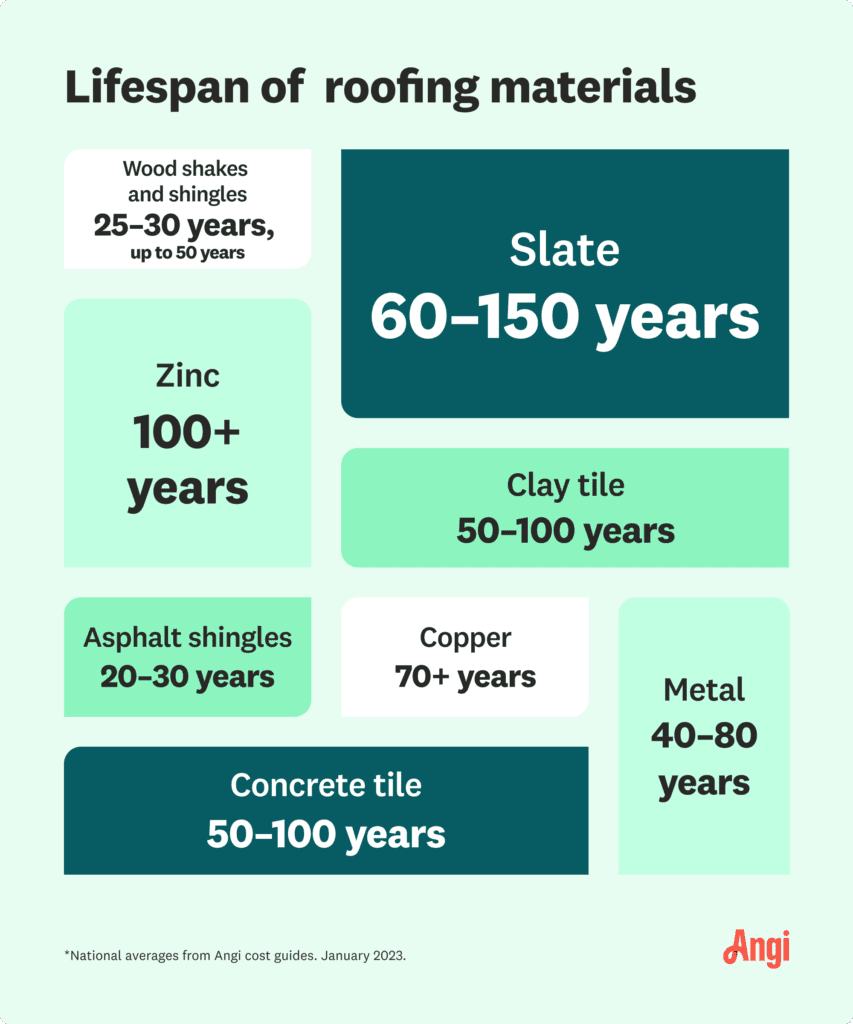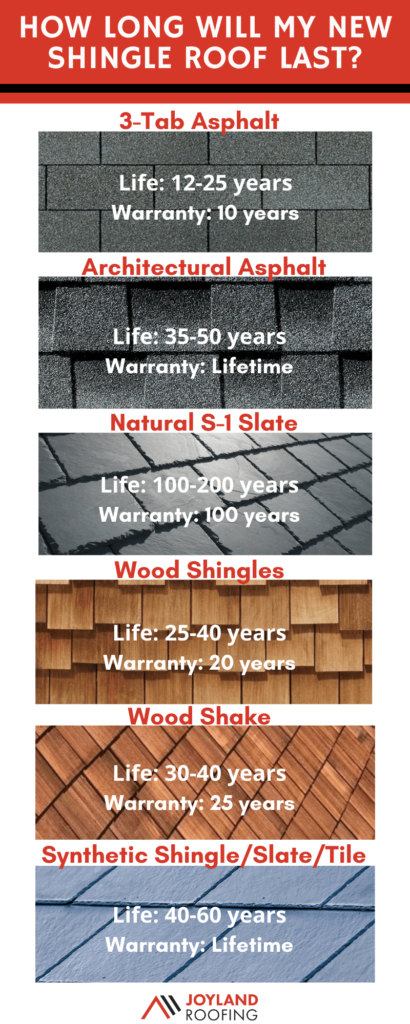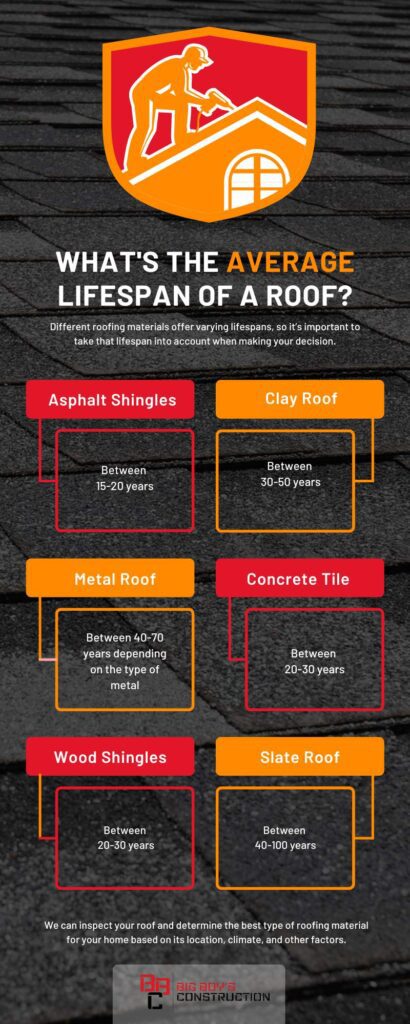Have you ever wondered how long a roof lasts? It’s a question that often comes to mind when you’re a homeowner. After all, your roof is one of the most important parts of your house, protecting you and your belongings from the elements. In this article, we’ll explore the average lifespan of a roof, shedding some light on this commonly asked question. So, let’s dive into the world of roofing and find out just how long you can expect your roof to last.

Factors Affecting Roof Lifespan
Climate
The climate in which you live plays a significant role in the lifespan of your roof. Extreme weather conditions such as heavy rain, strong winds, hailstorms, and snow can take a toll on your roof over time. Constant exposure to these elements can cause deterioration and damage to the roofing materials, leading to a reduced lifespan.
Material Quality
The quality of the roofing materials used is another crucial factor that affects the longevity of your roof. Investing in high-quality materials, such as durable shingles or metal roofing, can significantly extend the lifespan of your roof. Cheaper materials may save you money upfront, but they are more prone to damage and will likely require replacement sooner.
Installation
Proper installation is essential for maximizing the lifespan of your roof. Even high-quality materials can fail prematurely if they are not installed correctly. Hiring a professional roofing contractor with experience and expertise in the installation of the specific roofing material you’ve chosen is vital. Improper installation can lead to a variety of problems, including leaks, sagging, and even structural damage.
Roof Slope
The slope of your roof also impacts its lifespan. Steeper roofs tend to have better water drainage, which reduces the risk of water pooling and leaking. A shallow-sloped roof, on the other hand, is more prone to water accumulation, leading to increased wear and tear over time. It’s important to choose a roof slope appropriate for your climate and the type of roofing material you’ve selected.
Maintenance
Regular maintenance is key to extending the lifespan of your roof. By keeping your roof clean and performing routine inspections, you can catch any potential issues early on and address them promptly. Regular maintenance tasks, such as clearing debris, cleaning gutters, and ensuring proper attic ventilation, can help prevent damage and maintain the overall integrity of your roof.
Different Types of Roofing Materials
Asphalt Shingles
Asphalt shingles are one of the most popular roofing materials due to their affordability and versatility. They come in various styles and colors, making them suitable for a wide range of architectural designs. Asphalt shingles typically have a lifespan of 20 to 30 years, depending on factors such as climate and maintenance.
Metal Roofing
Metal roofing is known for its durability and longevity. Metal roofs can withstand harsh weather conditions and are resistant to fire, rot, and insect damage. With proper maintenance, a metal roof can last 40 to 70 years or even longer, making it a great investment for homeowners looking for a long-lasting roofing option.
Wood Shakes
Wood shakes offer a natural and rustic look to your home. While they are aesthetically pleasing, they require regular maintenance to prevent mold, algae, and rot. Wood shakes usually have a lifespan of 20 to 40 years, depending on maintenance and climate factors.
Clay or Concrete Tiles
Clay or concrete tiles are known for their durability and resistance to fire, insects, and rot. They are a popular choice for homes with a Mediterranean or Spanish architectural style. Properly installed and maintained clay or concrete tile roofs can last 50 years or more.
Slate
Slate is a high-end roofing material known for its elegance and longevity. It is resistant to fire, rot, and insects and can withstand extreme weather conditions. A well-maintained slate roof can last 75 to 100 years, making it one of the most durable roofing options available.
Rubber
Rubber roofing, also known as EPDM (ethylene propylene diene terpolymer), is a synthetic roofing material that offers excellent durability and weather resistance. It is commonly used in low-slope or flat roofs. With proper maintenance, a rubber roof can last 25 to 30 years.
Average Lifespan of Roofing Materials
Asphalt Shingles
As mentioned earlier, the average lifespan of asphalt shingles ranges from 20 to 30 years. However, it is important to note that this can vary depending on various factors, such as the quality of the shingles, installation, maintenance, and climatic conditions.
Metal Roofing
Metal roofs have a significantly longer lifespan compared to asphalt shingles. On average, metal roofing can last 40 to 70 years or more, making it a durable and long-lasting option for homeowners.
Wood Shakes
Wood shakes typically have a lifespan of 20 to 40 years. However, this can vary depending on the type of wood used, maintenance practices, and the climate in which the roof is located.
Clay or Concrete Tiles
Clay or concrete tiles have an average lifespan of 50 years or more. Proper installation and regular maintenance can further extend their durability and lifespan.
Slate
Slate roofs are known for their exceptional longevity, with an average lifespan of 75 to 100 years or more. Their natural durability and resistance to various elements make them one of the longest-lasting roofing materials available.
Rubber
With proper maintenance, a rubber roof can last 25 to 30 years. However, it is essential to note that the lifespan of rubber roofing can be affected by factors such as exposure to UV radiation, extreme temperatures, and poor installation.
Signs of a Roof in Need of Replacement
Leaks
One of the most obvious signs that your roof may need replacement is the presence of leaks. If you notice water stains on your ceilings or walls, it could indicate that your roof’s protective barrier has been compromised, and water is seeping through.
Curling or Buckling Shingles
Shingles that are curling or buckling are a clear indication that your roof is deteriorating. This is often caused by moisture absorption, excessive heat, or poor installation. If left unaddressed, curled or buckled shingles can lead to further damage and potentially more significant issues with your roof.
Missing Shingles
Missing shingles can expose your roof to potential water damage and can be a sign that your roof is nearing the end of its lifespan. High winds, heavy rain, or improper installation can cause shingles to become loose or completely detach from your roof.
Visible Damage or Aging
If you notice visible signs of damage or aging, such as cracked, warped, or blistered shingles, it may be an indication that your roof needs replacement. These signs of wear and tear can occur over time due to exposure to the elements and can compromise the overall integrity of your roof.
Excessive Granule Loss
Asphalt shingles often have a layer of granules that help protect the shingles from UV rays and provide additional fire resistance. If you notice excessive granule loss in your gutters or at the base of downspouts, it may indicate that your shingles are nearing the end of their lifespan and need replacement.

Factors to Consider in Roof Replacement
Cost
The cost of roof replacement is an important factor to consider. While it may be tempting to opt for cheaper materials or a quick fix, it is crucial to invest in a quality roof that will provide long-lasting protection for your home. Consider the overall value and benefits of different roofing materials and choose one that fits your budget without compromising on quality.
Durability
When it comes to roof replacement, durability is key. Look for materials that are known for their longevity and resistance to the elements. A durable roof will provide you with peace of mind and reduce the need for frequent repairs or replacements in the future.
Climate Compatibility
Consider the climate in which you live when selecting a new roof. Different roofing materials are better suited for specific climates. For example, metal roofing is an excellent choice for areas prone to high winds or hailstorms, while clay or concrete tiles perform well in warmer climates.
Aesthetics
The aesthetic appeal of your roof is another factor to consider. The roof is a prominent feature of your home’s exterior, and choosing a material that complements the overall design and style of your house can enhance its curb appeal and increase its value.
Fire Resistance
Fire resistance is an important consideration, particularly in areas prone to wildfires or with strict fire safety regulations. Certain roofing materials, such as metal or concrete tiles, offer better fire resistance than others. Prioritizing fire-resistant materials can provide added protection for your home and potentially lower your insurance premiums.
Roof Maintenance Tips
Regular Inspections
Regular inspections are essential for identifying any potential issues with your roof. Inspect your roof at least twice a year, in spring and fall, and after severe weather events. Look for signs of damage, such as missing shingles, cracked flashing, or damaged gutters.
Clearing Debris
Clear any debris, such as leaves, branches, or dirt, from your roof regularly. Accumulated debris can trap moisture, leading to roof decay and potential leaks. Use a roof rake or soft-bristle broom to gently remove debris without causing any damage to the roofing material.
Gutter Cleaning
Clean your gutters and downspouts regularly to ensure proper water drainage. Clogged gutters can lead to water backup, which can damage your roof and cause leaks. Remove leaves and other debris from your gutters and check for any signs of damage or leaks.
Attic Ventilation
Proper attic ventilation is crucial for maintaining the longevity of your roof. It helps regulate temperature and moisture levels, preventing the buildup of excess heat and condensation that can lead to roof damage. Ensure that your attic is adequately ventilated by installing vents or fans as recommended by a professional.
Roof Cleaning
In areas prone to algae or moss growth, consider regular roof cleaning. Algae and moss can trap moisture and cause damage to your roof. Use a gentle cleaning solution and a soft brush to remove any growth without damaging the roofing material. Be cautious and avoid walking on the roof to prevent any accidental damage.

Benefits of Regular Roof Maintenance
Extend Roof Lifespan
Regular roof maintenance can significantly extend the lifespan of your roof. By addressing minor issues early on and preventing further damage, you can avoid the need for premature roof replacement and potentially save thousands of dollars in the long run.
Early Problem Detection
Routine inspections and maintenance allow you to detect any potential problems with your roof early on. Catching issues, such as leaks or damaged shingles, in their initial stages can prevent them from escalating into more significant and costlier repairs.
Preserve Home Value
Maintaining a well-kept roof enhances the overall value and curb appeal of your home. A roof in good condition is an essential selling point and can make a significant difference in attracting potential buyers when the time comes to sell your property.
Prevent Costly Repairs
Addressing minor roof issues promptly through regular maintenance can help prevent more extensive and costly repairs down the line. By taking care of small leaks or damaged areas, you can avoid water damage to your home’s interior, structural issues, and potential mold growth.
Energy Efficiency
A well-maintained roof with proper insulation and ventilation can contribute to improved energy efficiency in your home. By preventing heat transfer and excessive heat buildup, you can reduce your energy consumption and lower your heating and cooling costs.
Roof Replacement vs. Roof Repair
Extent of Damage
The extent of the damage is a crucial factor in determining whether your roof needs replacement or repair. Minor issues, such as a few missing shingles or small leaks, can typically be repaired. However, if the damage is extensive, such as widespread shingle deterioration or sagging, it may be more cost-effective and practical to replace the entire roof.
Age of Roof
Consider the age of your roof when deciding between replacement or repair. If your roof is nearing the end of its expected lifespan and experiencing multiple issues, replacement is often a better long-term solution. Repairing an old roof may provide temporary fixes but can lead to more frequent repairs and increased costs in the future.
Cost Considerations
The cost of repairs versus replacement is an important consideration. While repairs may seem more affordable initially, multiple repairs over time can add up, making a full roof replacement more cost-effective in the long run. Obtain estimates for both repair and replacement from reputable roofing contractors to make an informed decision.
Long-Term Roofing Goals
Consider your long-term goals for your roof. If you plan to stay in your home for many years, investing in a new roof with a longer lifespan can provide peace of mind and reduce the need for frequent repairs or replacements. However, if you are planning to sell your home in the near future, a cost-effective repair may be sufficient.
Overall Structural Integrity
The overall structural integrity of your roof is a critical factor. If your roof’s structural components, such as rafters or decking, are compromised, a roof replacement may be necessary to ensure the safety and stability of your home. Consult with a professional roofer to assess the structural integrity of your roof.

Choosing the Right Roofing Contractor
Research and Referrals
When choosing a roofing contractor, conduct thorough research and seek referrals from friends, family, or neighbors who have had positive experiences. Check online reviews and ratings to ensure you select a reputable and reliable contractor with a track record of delivering quality workmanship.
Licensing and Insurance
Verify that the roofing contractor is licensed and adequately insured. Proper licensing indicates that the contractor meets the necessary industry standards and regulations. Insurance coverage protects you from liability in case of accidents or property damage during the roofing project.
Manufacturer Certifications
Look for roofing contractors who have manufacturer certifications. These certifications indicate that the contractor has met rigorous training and quality requirements set by the manufacturer of your chosen roofing material. Working with a certified contractor ensures that your roof is installed correctly and in accordance with the manufacturer’s guidelines.
Written Estimates
Obtain written estimates from multiple roofing contractors before making a decision. Compare the scope of work, materials, warranties, and pricing to ensure you have a clear understanding of the project and can make an informed choice. Be wary of unusually low estimates, as they may indicate subpar materials or workmanship.
Warranty
Inquire about the warranty offered by the roofing contractor. A reputable contractor should provide a warranty for both labor and materials. Familiarize yourself with the terms and conditions of the warranty to ensure you have proper coverage in case of any issues or defects.
Conclusion
Your roof is a critical component of your home, protecting you and your belongings from the elements. Understanding the factors that affect the lifespan of your roof, the different types of roofing materials available, signs of a roof in need of replacement, and the importance of regular maintenance can help you make informed decisions to care for your roof properly. Whether you choose to repair or replace your roof, remember to prioritize quality materials, professional installation, and regular maintenance to maximize its lifespan and ensure your home remains safe and secure for years to come.
